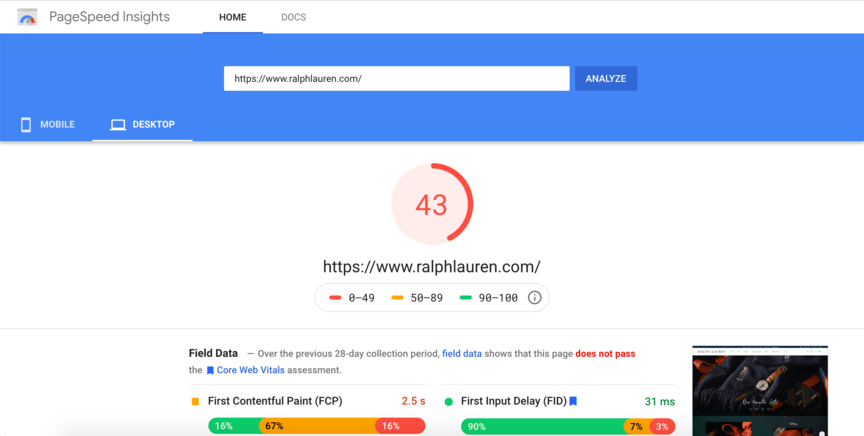Think back to a few seconds ago when you clicked the link that led you to this page. Now picture the page loading in your head and count out fifteen seconds. Long before you reached fifteen, you’d probably give up, right? You’d be flabbergasted if this page loaded that slow.
Clearly, having a good page load speed is important for any website, including your own. But how can you gauge whether or not your page speeds are good? What, for example, is the average page load time?
Below, we’ll discuss the basics of page load speed:
- The average page load speed
- Why page load speed matters
- How you can improve page load speed
What is the average page load time?
Before we go any further, we’ll go ahead and address the question of what the average page load time is. Let’s clarify that when we say, “average page load time,†we’re referring to the time it takes for a page to fully load from start to finish.
So, what is the average page load time? According to one study, it’s 10.3 seconds on desktop computers. Of course, page speeds are usually different on desktop and mobile devices. The same study found that the average mobile speed is 27.3 seconds.
The results are similar for eCommerce sites specifically — the top 500 eCommerce sites have a median page load time of 10 seconds on desktop.
After seeing these numbers, you may think this is the baseline you need to hit and that if you reach this number, your page speed is good. That’s not the case — you want to optimize your site to load as quickly as possible to deliver the best user experience.
In other words, don’t settle for being average — average doesn’t drive results! Instead, aim to be as fast as you can so you can retain more traffic and drive more conversions.

Why page load speed matters
If your pages load slowly, you’ll be inclined to ask, “So what? What’re a couple of extra seconds?†And it’s easy to urge into that frame of mind when you’re watching it from the attitude of a site builder. But as a visitor, you’d quickly realize just how important page speed is.
The fact is, 83% of users expect the pages they visit to load within three seconds. As short as three seconds may sound, it’s quite a while when it involves page load speeds. Just try loading a page then counting out three seconds — you’ll quickly see the difference!
When users encounter a page that takes too long to load, they’ll usually find themselves bouncing — that’s, hitting the rear button to return to look results and appearance for a faster-loading page.
When Google sees people bouncing, it’ll assume your page isn’t relevant to look results and can rank you lower. meaning that having a slow-loading website can hurt your program optimization (SEO) strategy and make it harder for people to seek out you.
Improving your page load speeds, then, can do tons to approach your rankings and site traffic. In fact, once you increase your page speeds by one second, you’ll approach conversions by 7%.
3 ways to improve page load time
The final question to answer is this: How can you improve page load times on a slow-loading website? Depending on how dedicated you are to making your pages faster, there are actually quite a few things you can do. These three, in particular, should make the top of your list:
1. Compress images
One of the simplest ways to create a good page load speed is to compress the images on your website, which you can do on websites like Kraken.io.
When we mention the dimensions of a picture, we don’t mean the space it takes abreast of the screen. We mean the file size in bytes, which features a large effect on your page speeds.
Large file sizes take much longer to load. A page with large images thereon will load slower than a page with optimized images. once you compress images, you decrease the file size without compromising the general look of your site and help your pages load faster.
2. Limit redirects
Redirects are another factor that will contribute to slow-loading websites. once you remove a page from your site, you want to confirm that no other pages are linking thereto. If there are, users will find themselves getting a mistake screen if they struggle to go to the newly nonexistent page.
To prevent these issues, you’ll create redirects, which essentially reroute Google and users to a special page than the one linked to. the matter is that these redirects cause significantly longer load times.
To keep your page speeds fast, attempt to limit how often you would like to believe redirects. you’ll do that by removing links to deleted pages, or by changing the links to require users on to a replacement page instead of doing so via a redirect.
3. Minify code
Whenever Google loads a page, it loads everything within that page’s code. The more complex and lengthier that code is, the longer it will take the page to load.
Another way to give your page load speed a boost is to minify a page’s code. That means trimming it to remove unnecessary items like commas, formatting, and spaces.
Reach a good page load speed for your site with Digitizal
Need help getting your page load speeds where you want them? Don’t worry — Digitizal has your back! With over 5 years+ of experience in SEO and web design, we know just how to optimize your site to load quickly.
With our page speed optimization services, you’ll get help implementing each of the tips listed above and more. You’ll also receive a dedicated account representative to keep close in touch with you on everything we do for you.
To get started with us, just call +92 3178866096 or contact us online today!








